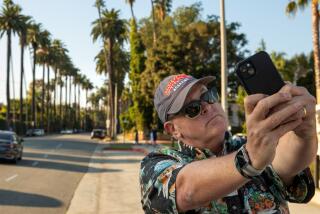The science of selfies is serious business -- and seriously revealing
- Share via
After combing through 656,000 photos on Instagram from five global cities, a team of data researchers has come to a conclusion: Selfies say more about you than you think.
The science of selfies is serious business, says Lev Manovich, project coordinator behind SelfieCity.net.
“Selfies, you know we have interesting opinion, but they are just based on maybe a few thousand selfies we look at,” said the Russian-born researcher and author in heavily accented English. “We thought, why don’t we take a more objective look.”
To study the selfie phenomenon, Manovich -- a computer science professor at City University New York -- and a team of seven researchers scanned the globe. They downloaded hundreds of thousands of images and analyzed them using automatic image analysis as well as human judgment.
PHOTOS: Amazing images of 2014 so far
Perhaps their most interesting finding was the relatively tiny number of selfies posted to social media, Manovich said.
In fact, only 3% to 5% of all photos the team analyzed could be categorized as a selfie, according to the research team.
“I think it’s partly because people take selfies, but [they] don’t share them with the public,” Manovich said, adding that not all selfies taken end up on Instagram. In countries such as Brazil and Russia, people tend to use local social media services, not Instagram, he said.
Beyond the number of selfies posted, the team looked at subtle cultural differences in the way people take selfies.
“For example, look at Tokyo, they don’t really pose. They try to hide their face, look down,” Manovich said. “Not everyone is trying to make this kind of Photoshop-looking picture.”
According to the data, women are more likely to strike an extreme selfie pose: They tilt their heads at a greater angle -- a 12.3-degree tilt as opposed to 8.2 degrees for men. But in São Paulo, women tilt their heads at the greatest angle -- 16.9 degrees.
The researchers scored the selfies on “happiness,” based on smiles. Those in Bangok smiled the most with a 0.68 happiness score (0.7 being the highest). People taking selfies in Moscow look a lot less thrilled, with a happiness score of 0.53.
Women also take significantly more selfies than men, 1.3 times as many in Bangkok and 1.9 times as many in Berlin. Moscow, however, takes the female selfie cake, with 4.6 times more women striking a pose than men.
Along with the data collection, the team also produced several thesis papers looking at why people take self-portraits in the first place.
In her paper, PhD. student Alise Tifentale theorizes that by sharing a selfie the user is trying to “express their belonging to a community or a wish to belong to one.”
Tifentale adds that by showcasing yourself in particular clothes, while wearing a particular expression, “people can convey a particular public image of themselves, presumably one that they think will garner social rewards.”
Still, Manovich said that there still is no one reason why people snap selfies.
“There’s not one single theme. Some people take them to look glamorous in front of their friends. Some people take it because it’s more like a very casual indication, or ‘I’m here in this point in time,’ almost like you’re touching somebody,” Manovich said. This self photography may be indicative, he said, of a whole new photography movement and a way for individual self-expression.
“It’s almost like a new landscape, or a new thought process: ‘I am a part of this picture.’ “
Manovich encourages everyone to play with the data on SelfieCity.net and come to his or her own conclusions on selfies.
Want to talk more about selfies? Follow me on Twitter @Sleasca
More to Read
Sign up for Essential California
The most important California stories and recommendations in your inbox every morning.
You may occasionally receive promotional content from the Los Angeles Times.









